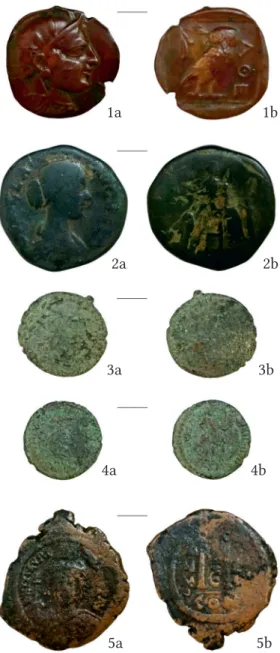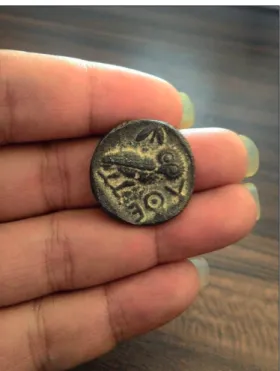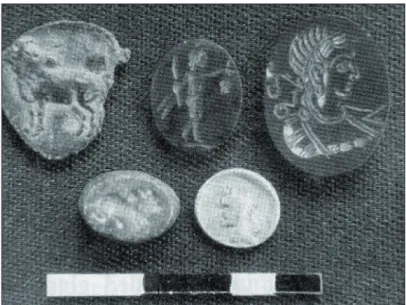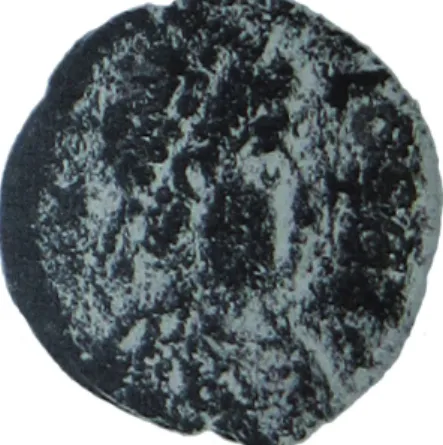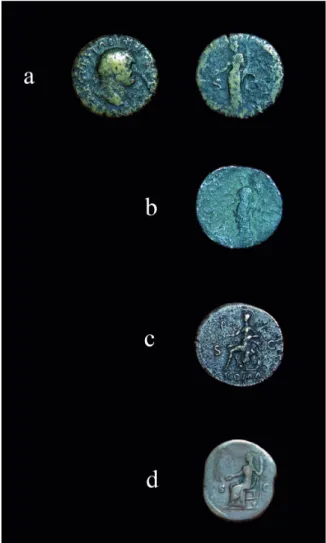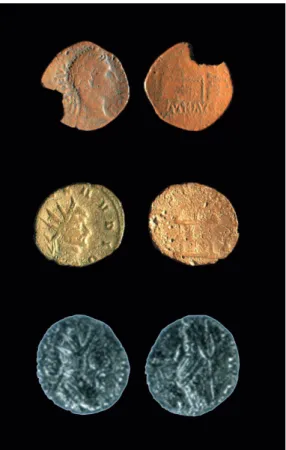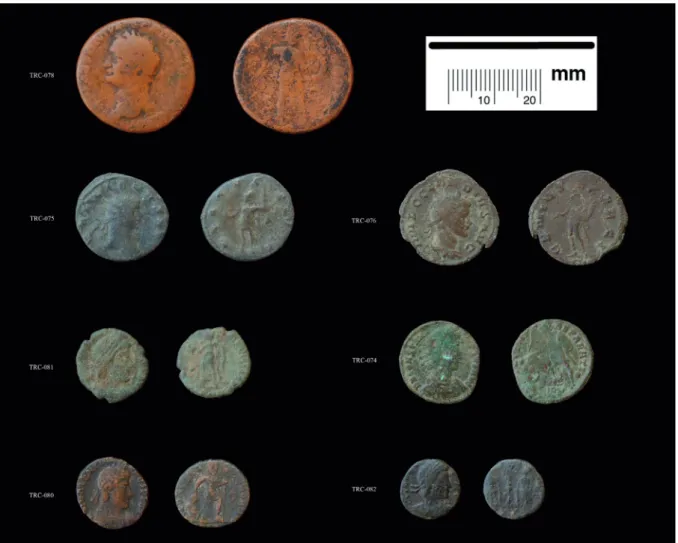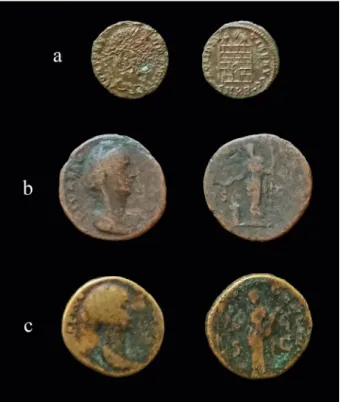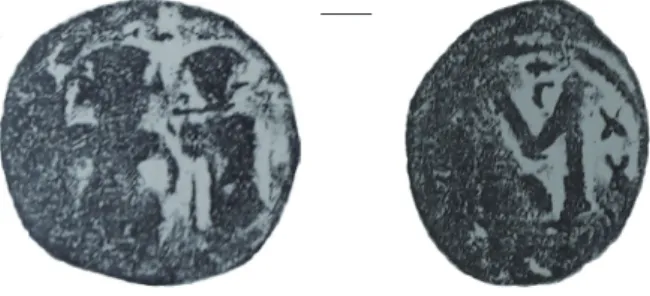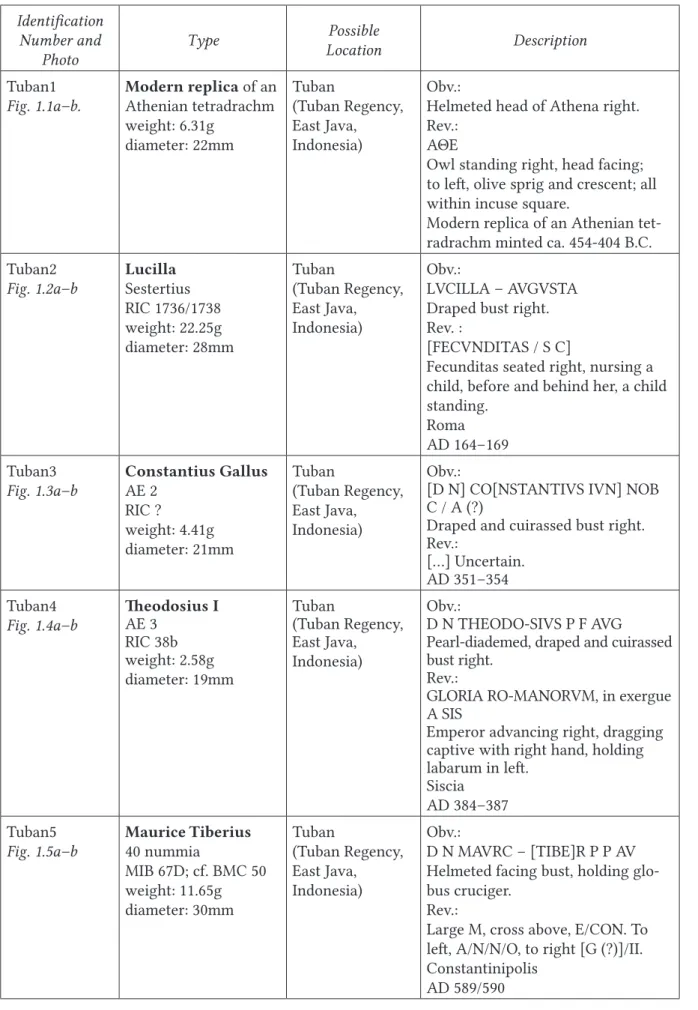Ser. 3. No. 6. 2018 |
DISSERT A TIONES ARCHAEOLO GICAE
Arch Diss 2018 3.6
D IS S E R T A T IO N E S A R C H A E O L O G IC A E
Dissertationes Archaeologicae
ex Instituto Archaeologico
Universitatis de Rolando Eötvös nominatae Ser. 3. No. 6.
Budapest 2018
Universitatis de Rolando Eötvös nominatae Ser. 3. No. 6.
Editor-in-chief:
Dávid Bartus Editorial board:
László BartosieWicz László Borhy Zoltán Czajlik
István Feld Gábor Kalla
Pál Raczky Miklós Szabó Tivadar Vida
Technical editor:
Gábor Váczi Proofreading:
ZsóFia KondÉ Szilvia Bartus-Szöllősi
Aviable online at htt p://dissarch.elte.hu Contact: dissarch@btk.elte.hu
© Eötvös Loránd University, Institute of Archaeological Sciences Layout and cover design: Gábor Váczi
Budapest 2018
Zsolt Mester 9 In memoriam Jacques Tixier (1925–2018)
Articles
Katalin Sebők 13
On the possibilities of interpreting Neolithic pottery – Az újkőkori kerámia értelmezési lehetőségeiről
András Füzesi – Pál Raczky 43
Öcsöd-Kováshalom. Potscape of a Late Neolithic site in the Tisza region
Katalin Sebők – Norbert Faragó 147
Theory into practice: basic connections and stylistic affiliations of the Late Neolithic settlement at Pusztataskony-Ledence 1
Eszter Solnay 179
Early Copper Age Graves from Polgár-Nagy-Kasziba
László Gucsi – Nóra Szabó 217
Examination and possible interpretations of a Middle Bronze Age structured deposition
Kristóf Fülöp 287
Why is it so rare and random to find pyre sites? Two cremation experiments to understand the characteristics of pyre sites and their investigational possibilities
Gábor János Tarbay 313
“Looted Warriors” from Eastern Europe
Péter Mogyorós 361
Pre-Scythian burial in Tiszakürt
Szilvia Joháczi 371
A New Method in the Attribution? Attempts of the Employment of Geometric Morphometrics in the Attribution of Late Archaic Attic Lekythoi
The Roman aqueduct of Brigetio
Lajos Juhász 441
A republican plated denarius from Aquincum
Barbara Hajdu 445
Terra sigillata from the territory of the civil town of Brigetio
Krisztina Hoppál – István Vida – Shinatria Adhityatama – Lu Yahui 461
‘All that glitters is not Roman’. Roman coins discovered in East Java, Indonesia.
A study on new data with an overview on other coins discovered beyond India
Field Reports
Zsolt Mester – Ferenc Cserpák – Norbert Faragó 493
Preliminary report on the excavation at Andornaktálya-Marinka in 2018
Kristóf Fülöp – Denisa M. Lönhardt – Nóra Szabó – Gábor Váczi 499 Preliminary report on the excavation of the site Tiszakürt-Zsilke-tanya
Bence Simon – Szilvia Joháczi – Zita Kis 515
Short report on a rescue excavation of a prehistoric and Árpádian Age site near Tura (Pest County, Hungary)
Zoltán Czajlik – Katalin Novinszki-Groma – László Rupnik – András Bödőcs – et al. 527 Archaeological investigations on the Süttő plateau in 2018
Dávid Bartus – László Borhy – Szilvia Joháczi – Emese Számadó 541 Short report on the excavations in the legionary fortress of Brigetio (2017–2018)
Bence Simon – Szilvia Joháczi 549
Short report on the rescue excavations in the Roman Age Barbaricum near Abony (Pest County, Hungary)
Szabolcs Balázs Nagy 557
Recent excavations at the medieval castle of Bánd
Rita Jeney 573 Lost Collection from a Lost River: Interpreting Sir Aurel Stein’s “Sarasvatī Tour”
in the History of South Asian Archaeology
István Vida 591
The Chronology of the Marcomannic-Sarmatian wars. The Danubian wars of Marcus Aurelius in the light of numismatics
Zsófia Masek 597
Settlement History of the Middle Tisza Region in the 4th–6th centuries AD.
According to the Evaluation of the Material from Rákóczifalva-Bagi-földek 5–8–8A sites
Alpár Dobos 621
Transformations of the human communities in the eastern part of the Carpathian Basin between the middle of the 5th and 7th century. Row-grave cemeteries in Transylvania, Partium and Banat
Roman coins discovered in East Java, Indonesia
A study on new data with an overview on other coins discovered beyond India
Krisztina Hoppál István Vida
MTA-ELTE-SZTE Silk Road Research Group1 Hungarian National Museum
hoppalkriszti85@gmail.com vida.istvan@hnm.hu
Shinatria Adhityatama Lu Yahui
National Archaeological Research Center, Institute of Archaeology
Jakarta Chinese Academy of Social Sciences
shinatriaadhityatama@gmail.com luyahuipku@126.com
Abstract
Studying extra regional trade networks in Antiquity can be considered a relatively popular field of research, but the intensity and patterns of such complex system still leave lot of questions, particularly in the case of Rome’s Far Eastern trade. There is still a trend to visualize a kind of globalized commercial activity between the Imperium and communities on the eastern edge of the Silk Road(s). However, the facts provide us a more comprehensive picture. Due to the meticulous work of international joint research projects working in East and Southeast Asia followed by a raised interest in collecting ancient objects among local people, an increas- ing number of Roman objects have been discovered in the region. These finds prove the significance of medi- ator cultures in transferring Roman artifacts beyond India – with their own imprints on forming evaluation/
acceptance of these non-local goods by the receiving culture.
At the same time, one must keep in mind that Roman objects discovered in East and Southeast Asia have different backgrounds, and most cases – due to extensive looting – are lacking an archaeologically secure context. Therefore, a careful approach towards these finds is essential along with the re-evaluation of earlier discoveries. Detailed and objective report of Roman artifacts newly discovered in East and Southeast Asia – whatever their background may be – is a first step towards a more elaborate study. In the following pages, fourteen Roman and Byzantine coins along with eleven Chinese coins found in different locations in East Java will be studied. However, the authors had only limited access to some of the coins, thus some basic information (clear, high resolution photos, measurements etc.) are lacking.
Despite the abovementioned difficulties, the paper not only gives identification to these finds but also gathers other Roman coins discovered beyond India along with the re-identification of some earlier discoveries. In the end, it intends to provide possible explanations on how they
1 The research was conducted during the 2018 MOFA Taiwan Fellowship at the Institute of History and Phi- lology, Academia Sinica. The authors would like to emphasise that the coins were discovered by local people and were kindly provided by Shinatria Adhityatama for further research. Thus no field research was con- ducted by the other authors, and there is no intention to do any kind of field works without the permission of Indonesian authorities.
ended up in East Java, a region that is terra incognita in regards of Roman studies, taking all the suspicious details on their finding context into account.
Western coins from Tuban Regency
In 2016, five Western coins were reported to be found by local peasants in the vast area of Tuban Regency. Each coin was said to be discovered in a different location without revealing any more details on their finding circumstances or on their distances from one another.
If the locals’ account is to be credited, a Roman sestertius, two late Roman bronzes, and a Byzantine follis as well as a fifth coin, a modern replica of a Greek tetradachm were found separately without any connection to each other. However, the presence of a modern replica is highly suspicious.
The replica was modeled of an Athenian tetradrachm minted ca. 454-404 B.C. On the obverse the helmeted head of Athena, facing right. On the reverse the Greek legend AΘE with the owl, standing right, head facing to the left, an olive sprig and a crescent, all within an incuse square (ID No. Tuban1, Fig. 1.1a–b).
Among the Roman coins, a sestertius of Lucilla minted at Rome between 164 and 169 was found.
On the obverse Latin legend LVCILLA – AVGVSTA around the draped bust of Lucilla facing right. On the reverse Latin legend [FECVNDITAS] around Fecunditas seated right, nursing a child, before and behind her, a child standing; S C in exergue. Since the sex of the children cannot be determined, the exact type (RIC 1736 or 1738) cannot be defined (ID No. Tuban2, Fig. 1.2a–b).
An AE2 of Constantinus Gallus dated between 351 and 354 was also found. On the obverse the Latin legend [D N] CO[NSTANTIVS IVN] NOB C around draped and cuirassed bust of Constantius Gallus facing right, A in left field. On the reverse Latin legend [FEL TEMP REPARATIO] around soldier spearing a fallen horseman. Uncertain mintmark in exergue. RIC ? (ID No. Tuban3, Fig. 1.3a–b).
The third coin is an AE3 of Theodosius I minted at Siscia between 384 and 387. On the obverse Latin legend D N THEODO-SIVS P F AVG around pearl-diademed, draped and cuirassed bust of Theodosius I facing right. On the reverse Latin legend GLORIA RO-MANORVM around an emperor advancing right, dragging a captive with right hand, holding a labarum in the left.
Mint-mark A SIS in exergue. RIC 38b (ID No. Tuban4, Fig. 1.4a–b).
The fourth coin is a 40 nummia coin of Maurice Tiberius minted at Constantinople in 589/590. On the obverse Latin legend D N MAVRC – [TIBE]R P P AV around the helmeted, facing bust of Maurice Tiberius, holding globus cruciger. On the reverse a large M (Greek numeral 40), cross above; to the left, A/N/N/O, to the right [G (?)]/II (regnal year 8), officina number E (Greek numeral 5) below; mint-mark CON in exergue. MIB 67D; cf. BMC 50 (ID No. Tuban5, Fig. 1.5a–b).
The above Roman and Byzantine coins are all small denominations with little value, they are common all around the Empire,2 which could be in circulation for more than a century or two, but usually only for a few decades.3
2 In the 4th century from Londinium to Alexandria 20 mints were producing bronze coins all over the Roman Empire: see RIC VI, VII, VIII, IX.
3 For an overview of late Roman bronze hoards: RIC X, cxxviii–clxx.
As for the modern replica, similar coins have been copied not only by swindlers in order to cheat buyers, but also legit- imately by museums and commercial replica makers, with no intent to de- ceive. A quite similar coin was discov- ered in Flores (for details see below), suggesting that more Greek replicas might have reached the Indonesian archipelago – undoubtedly in modern times. Other modern replicas can be found in Sri Lanka as well. Walburg mentions a Syracuse tetradachm from the same period along with a few lat- er coins, all most probably cast modern forgeries, some of them were offered for sale in 1994, others in 1998. How- ever, all those mentioned by Walburg were made of silver (or a material that looked like silver), unlike their bronze counterpart from the Tuban region.4 Although the exact location where the coins were discovered is unknown, it is difficult not looking for connections with the town of Tuban. The town has a particular historical significance partly thanks to its favorable geographical con- ditions. It was already mentioned as a famous port in Hindu-Buddhist inscrip- tions as early as the 11th–12th centuries.
From the 13th century Tuban is known as one of the major ports5 of the notable Majapahit Empire (1293 – 16th century), 6 and was also mentioned in Chinese his- torical records. 7 It kept its economic and cultural importance in the colonial peri- od as does in modern times.
A presumable coin hoard from the Brantas River
In 2017, a small hoard of Roman and Chinese coins was found by local gold panners in the
4 Walburg 2008, 183–184, Fig. 2.102.
5 About Tuban in the Majapahit Kingdom e.g.: Tjandrasasmita 2010; Muljana 2007.
6 F. Kovács 2014.
7 On Tuban in detail: Pratomo 2000; Sedyawati 1992.
Fig. 1. 1a–b – Modern replica of an Athenian tetra- drachm from the Tuban Regency, 2a–b – Sestertius of Lucilla from the Tuban Regency, 3a–b – AE of Constantius Gallus from the Tuban Regency, 4a–b – AE of Theodosius I from the Tuban Regency, 5a–b – Coin of Maurice Tiberius from the Tuban Regency from the Brantas River near Trowulan (©Shinatria Adhityatama).
1a 1b
2a 2b
3a 3b
4a 4b
5a 5b
Brantas River near Trowulan, a site that has been theorized as the place of the eponymous capital city of the Majapahit Empire. According to the locals’ brief report, the coins were scattered in the riverbed close to each other.
There were 10 Roman coins:
• An AE3 of Constantine I minted at Heraclea in 324. On the obverse Latin legend CONSTAN-TINVS AVG around the laureate head of Constantine I facing right. On the reverse Latin legend D N CONSTANTINI MAX AVG around laurel wreath enclosing [VOT XX]. Mint-mark S M H [...] in exergue. RIC 56 or 60 (ID No. Brantas1, Fig. 2.1a–b).
• An AE4 of Constans dated between 342 and 348.8 On the obverse Latin legend D N CONSTA-NS P F AVG around the rosette-diademed head of Constans facing right. On the reverse Latin legend VOT / XX / MVLT / XXX in laurel wreath. Uncertain mint- mark in exergue. RIC ? (ID No. Brantas2, Fig. 2.2a–b).
• An antoninian of Claudius II minted at Rome between 268 and 270. On the obverse Latin legend IMP C CLAVDIVS AVG around the radiate, cuirassed bust of Claudius II facing right. On the reverse Latin legend [VICTO]R[I]A AVG around Victory stand- ing left, holding wreath and palm. RIC 104 (ID No. Brantas3, Fig. 2.3a–b).
• An AE4 of Constantius Caesar minted at Constantinopolis between 336 and 337. On the obverse Latin legend [FL IVL] CONSTANTIVS NOB C around the laureate, draped and cuirassed bust of Constantius II facing right. On the reverse Latin legend GLORIA EXERC-ITVS · around standard between two soldiers holding spear and resting on shield. Mint-mark CONS [...] in exergue. RIC 151 (ID No. Brantas4, Fig. 2.4a–b).
• An AE4 of Constans minted at Thessalonica between 342 and 348.9 On the obverse Latin legend D N CONSTA-NS P F AVG around the rosette-diademed(?), draped and cuirassed bust of Constans facing right. On the reverse Latin legend VICTORIAE DD AVGGQ NN around two Victories facing one another, each holding wreath and palm.
Mintmark S M TS [...] in exergue and palm-branch between the two Victories. RIC 106 (ID No. Brantas5, Fig. 2.5a–b).
• An AE3 of Constantius II minted at Siscia or Sirmium between 351 and 358. On the obverse Latin legend D N CONSTAN-[TIVS P F] AVG around the pearl-diademed, draped and cuirassed bust of Constantius II right. On the reverse Latin legend FEL TEMP – REPARATIO around a soldier spearing a fallen horseman. Mintmark B SI[...]
in exergue. RIC ? (ID No. Brantas6, Fig. 2.6a–b).
• An AE3 of Julian II minted at Sirmium between 355 and 358. On the obverse Latin legend D N IVLIA-NVS NOB C around the draped and cuirassed bust of Julian II. On the reverse Latin legend [FEL TEMP] – REPARATIO around a soldier spearing a fall- en horseman. Mintmark A SIRM · in exergue. RIC 70 (ID No. Brantas7, Fig. 2.7a–b).
• And an AE3 of Gratian minted at Siscia between 367 and 375. On the obverse Latin legend D N GRATIANVS P F AVG around the pearl-diademed, draped and cuirassed bust of Gratian right. On the reverse Latin legend GLORIA RO-MANORVM around emperor advancing right, dragging a captive with the right hand, and holding a laba- rum in the left. Mintmark Δ SISC R in exergue, M in left field, */R/O in right field. RIC 14c.XXIII (ID No. Brantas8, Fig. 2.8a–b).
8 RIC dates this type to 347–348. However, based on the great variety of mintmarks, and their ratio to other periods of the Constantinian dynasty, we think that 342–348 is more appropriate.
9 See note 8.
• An antoninian of Aurelian minted at Siscia between 270 and 275. On the obverse Lat- in legend [IMP AVREL]IANVS AVG around the radiate, cuirassed(?) bust of Aurelian facing right. On the reverse Latin legend [IO]VI CON-[SE]R around emperor stand- ing right, holding a sceptre in the left hand receiving globe from Jupiter standing left, holding sceptre in left hand. Mint-mark *T in exergue. The obverse is double struck.
RIC 225 (ID No. Brantas9, Fig. 2.9a–b).
• An assarion (Greek for as) of Severus Alexander minted in the provincial mint at Nicaea Bithyniae between 222 and 235. On the obverse Greek legend [...]ΔPOC AV[Γ]
(?) around laureate, draped bust of Severus Alexander facing right. On the reverse Fig. 2. 1a–b – AE of Constantine I from the Brantas River near Trowulan, 2a–b – AE of Constans from the Brantas River near Trowulan, 3a–b – Antoninian of Claudius II from the Brantas River near Trowu- lan, 4a–b – AE of II Constantius Caesar from the Brantas River near Trowulan, 5a–b – AE of Constans from the Brantas River near Trowulan, 6a–b – AE of Constantius II from the Brantas River near Trowu- lan, 7a–b – AE of Julian II from the Brantas River near Trowulan, 8a–b – AE of Gratian from the Brantas River near Trowulan, 9a–b – Antoninian of Aurelian from the Brantas River near Trowulan, 10a–b – Assarion of Severus Alexander from the Brantas River near Trowulan (©Shinatria Adhityatama).
1a 1b 2a 2b
3a 3b 4a 4b
5a 5b 6a 6b
7a 7b 8a 8b
9a 9b 10a 10b
Greek legend NI-KA-I-E/ΩN and three military standards. Waddington 617 (ID No.
Brantas10, Fig. 2.10a–b).
Although this type was minted at Nicaea Bithyniae, it was destined to circulate in the Mid- dle-Danubian region of the Roman Empire, primarily Moesia Superior and Pannonia Inferior.
Such coins were found from Britain to Syria, but 99% of the finds come from the Middle Dan- ubian region,10 where it was also imitated contemporaneously.11
Like in the case of the Tuban coins, the Brantas River finds are also small denominations with little value. As individual finds they can be found all around the Empire, being in circulation for a relatively long time. They are quite frequent in coin hoards or as scattered finds of the Carpathi- an Basin12 – although not typical in such combination – but rarely appear in India or beyond.13 Regarding the place and date of coins it can be presumed that the they traveled to Java together as an assemblage and not independently.
The eleven Chinese coins reported to be found together with the Roman ones are ranging from 758 to 1258. Three dynasties can be differentiated, Tang (618–907), Southern Song (1127–
1279) and Jin Dynasties (1115–1234), as there are four Tang, six Southern Song and one Jin coins. In this manner, the coin of Song Lizong 宋理宗 issued in 1258 defines the terminus post quem for the whole hoard.14
The presence of Chinese coins in East Java is a quite common phenomenon. Relations of Chinese coins and the Majapahit have been studied in great details. It is well-accepted that the vast majority of Chinese coins promoted to set up a new currency system in Java. 15 Coin hoards discovered both in coastal and inland regions of the island show similar combination to the Brantas coin find. Many of the hoards contain coins from the Tang to the Yuan Dynas- ties, with strong appearance of Song coins,16 just like in the case of the Brantas River finds.
However, as for the Roman coins, the problem is more complex. In order to get a better un- derstanding how these Western coins might ended up in East Java, it would be useful to look for possible examples beyond India.
Locals’ discoveries: Roman coins from Indonesia
Unfortunately, it is quite rare to unearth ancient coins from secure context in Indonesia as most coin finds, mainly Chinese coins, are discovered by locals. These ordinary people – be- cause of their desperate financial situation, and in many cases the lack of knowledge about value of ancient finds – are selling them at local markets.17
10 Calomino 2017.
11 Vida 2017.
12 E.g.: see FMRU I, FMRU II; FMRU III; RAFMU 1; RAFMU 2; RAFMU 3. We also had the opportunity to look over several 100 000 coins of collectors from Hungary and from the Northern Balkans, and look over tens of thousand coins smuggled from the Balkans and caught by customs officers.
13 See e.g.: Jansari 2012.
14 For detailed identifications see Appendix III by Lu Yahui.
15 E.g.: Cribb – Potts 1996,108.
16 For date and periodization of Chinese coins unearthed in Trowulan e.g.: Amelia 1991, 194–195. In English:
Amelia 1995, 102–103.
17 Reports of such discoveries can be found on various Indonesian websites. E.g.: https://www.yukepo.com/
hiburan/indonesiaku/5-penemuan-uang-koin-kuno-di-indonesia-bukti-eksisnya-peradaban-masa-lalu/
A rather striking analogy to the coins from East Java is provided by a blog of an Indonesian metal detector website. According to the very short re- port from 2015 May, a certain local man has found five Greek, Indo-Greek and Roman coins by using metal detector in Flores (Fig. 3). Although previous- ly it was assumed that these coins are the very first Greco-Roman coins from Indonesia,18 in reality, all coins are modern replicas. One of them is an Athenian tetradrachm – just like the replica from the Tuban area. The website has kindly provided further information regarding the find context.
According to their knowledge the coins were dis- covered in a deserted graveyard possibly started as early as the colonial period, thus the coins were suggested to belong to a Dutch collector.19 However, all replicas seem to be even more recent products, most likely from the 20th century.
More remarkable finds have been uploaded to Face- book in 27 October 2017, by a user from Jakarta.20 He claimed that the more than two dozen Roman coins along with Chinese coins and coins of Jambi Sultanate were found in Jambi (Sumatra).
The Western coins were of twenty-eight Roman (ranging from Augustus to the 4th century), a 7th century Byzantine and an uncertain, possibly Greek coin. Apart from the one as of Au- gustus, minted at Rome, all other coins are AE3s and AE4s, antoniniani, and folles dated to the late 3rd and early 4th century, minted at Siscia, Thessalonica and Heraclea. Despite the dif- ficulty of judging from the blurry photo available, it is significant that in four cases out of the twelve coins with visible mint marks, Siscia can be identified as the place of minting.
It is not without example to find Roman coins on Indonesian auction websites as well, howev- er – unlike Chinese coins on the same sites – their description never contains any information on possible finding context i.e. coming from Indonesian soil. The lack of such information might suggest that the sellers have acquired them from abroad. At the same time, it is an interesting coincidence that many of those sellers reside in Surabaya area (Gresik, Sidoarjo etc.) – relatively close both to Trowulan and Tuban.
Lost or found: Roman coins from Southeast Asia
Thailand
Looking for other Southeast Asian finds, Thailand, Vietnam and Cambodia provide the only examples. One of the most notable Southeast Asian Roman coin find was discovered in
(Last accessed: 05.08.2018).
18 http://www.tambang.id/blog/koin-kuno-kami-beli-dari-pengguna-detektor (Last accessed: 05.08.2018).
19 ATM PROMINING™ 2018, pers. comm.
20 All the attempts of the authors have failed to connect the above mentioned user.
Fig. 3. Western coin from Flores http://
w w w.tambang.id/blog/koin-kuno- kami-beli-dari-pengguna-detektor (Last accessed: 05.08.2018).
U Thong (Krabi Province, Thailand) along with possibly regionally produced Roman coin im- itations.21 The antoninan of Victorinus was minted at Cologne (France) in 269/270 (Fig. 4).
As B. Borell et al. has pointed out “these de- based coins of the Gallic empire with a minimal silver content were in circulation in the western provinces of the Roman empire until the end of the third century CE. They were not used in bulk in long-distance trade with India, although occasional finds of such coins are known from there”.22 The coin is usually considered the only Roman coin known from Thailand, al- though some publications cite another find from Khlong Thom (Krabi, Thailand). Unfortu- nately only pictures and rubbings of the coin
are mentioned.23 In fact, M. Veraprassert reports a Roman gold coin from the collection of Wat Khlong Thom. According to his short description it bears an image of a human face on the obverse, and some letters on the reverse, but is gravely worn and the motifs are blurred.24 A. Srisuchat credits a blurry picture of a Roman coin – convincingly the same as mentioned by M. Veraprassert – took along with some other non-local artifacts discovered in Khlong Thom, without giving any specific details (Fig. 5). B. Borell has kindly drawn the authors' attention to her recent study in which she clears the mystery of the above mentioned coin, and defines it as a non-Roman, most likely local find.25
Another Roman coin worn as a pendant was exhibited on the In- ternational Workshop on Defin- ing Dvāravatī in 2017. The aureus of Domitian minted at Rome is re- ported to be found in Bang Kluay Nok (Ranong Province, Thailand) near a huge wooden slab interpret- ed as a ‘part of ancient ship on a sandy beach’.26
Vietnam
Admittedly, the Antoninus dynasty coins from Óc Eo are the most rec- ognized Roman-related artefacts in
21 For more details on coin imitations from U Thong see: Borell 2014, 11–12, 35; Bennett 2017, 26–27.
22 Borell et al. 2014, 110; Borell 2008, 14.
23 Bennett 2017, 42.
24 Veraprassert 1992, 157.
25 Glover 1996, 65. The aforementioned photo taken by A. Srisuchat is also often cited see e.g.: Nonsook 2012, 51, etc.
26 Borell 2017, 152–153.
Fig. 4. Antoninian of Victorinus from U Thong (©Metropolitam Museum of Arts).
Fig. 5. A previously Roman-interpreted coin from Khlong Thom (Glover 1996, 65).
Southeast Asia. Three gold coin-shaped ornaments were reported by L. Malleret in his enor- mous corpus of Óc Eo finds.27 Two of them have been often cited as Roman coins, despite the fact that these are ornaments imitating Roman coin designs as B. Borell quite recently stressed out again.28 Apart from the above examples, other coin imitations were found in several lo- cations of Southeast Asia. These pendants most likely were made in the region, which would presuppose that there were Roman coins available that served as models for casting.29
L. Malleret – later repeated by J. C. M. Khoo and then J. Miksic – also mentions a wooden box containing five coins found in 5th May 1942 at the Ba Vì Mountain, near Hanoi (Fig. 6). Among these coins one is a ses- terce of Antoninus Pius, 138 AD; another is a coin of Constantine I, 306–337, one is perhaps of Theodosius II, 415–450; and one is possibly a Byzantine piece from the fifth century.30 Although the discovery was brief- ly reported in 1943 no further details have been given ever since.31 As B. Borell pointed out, the coins can no longer be found in the Museum of Hanoi where they were reported to be deposited after their discovery.32 L. Malleret again cites another bronze coin with the legend ANTONINVS. According to his short descrip- tion the coin was acquired from a sorcerer in Thân-phù village (Thừa Thiên-Huế province). Its origin was unknown to its new owner and there is no evidence that it had been found locally.33 A. de Longpérier reported a now lost bronze coin in 1864 found near Mỹ Tho (Tiền Giang Province) cited later by L. Malleret34. Judging from the short description the coin is believed to be an early coin of Maximinus I from the years 235–236 AD.35
As for Byzantine examples, a quite recent excavation in Nền Chùa yielded a worn and cor- roded bronze coin, probably an early Byzantine piece of the late 5th or early 6th century, most likely a coin of Anastasius (reigned 491–518 AD).36
Around 2012 G. Epinal has discovered four Roman coins of the same origin (Óc Eo – Ba Thê- Mountain surroundings) on a now deleted Vietnamese website. In three cases only the re- verses were available37 (Fig. 7). According to the pictures downloaded and then provided by G. Epinal, two dupondii of Vespasian (69–79 AD) were found. One with FORTVNAE - REDVCI or FIDES – PVBLICA, and another with FORTVNAE - REDVCI legends. The third coin is an
27 Malleret 1962, 115–117.
28 Borell 2008, 170–171.
29 Borell 2016, 108.
30 Malleret 1962, 382–383; Khoo 2003, 25; Miksic 2013, 50.
31 The report was published in the Cahiers de L’école française d’Extrême-Orient 34 (1943) 5, cited in Mall- eret 1957, 335 and Malleret 1962, 383, note 1.
32 Borell 2018, pers. comm.
33 Malleret 1962, 382–383.
34 Malleret 1962, 112, 380–381, 385.
35 See BMCRE Maximinus 2 or 63; also Borell 2014, 29, note 77.
36 Borell 2016, 109.
37 Epinal 2014, 47, note 55.
Fig. 6. Coin of Theodosius from the Ba Vì Mountain (Malleret 1962, Pl. XL).
as of Nero (54–68 AD), minted at Rome. The fourth one is possibly a coin of Faustina Minor or Lucilla, with the legend IVNO, Juno seated left, holding patera and sceptre on the reverse (145–169 AD).
G. Epinal also has knowledge on such coins from Southern Vietnam, near Saïgon and from the Ha Tien area.38
Cambodia
A dozen Roman coins ranging from the 1st to 4th centuries (from Augustus to Valens) were reported to be found in Angkor Borei and have been published by G. Epinal39 (Figs 8–9).
The coins were said to be found relatively close to the Angkor Borei River, southeast of the monastery of the royal landing stage (Wat Kompong Luong) in the Angkor Borei admin- istrative district during a house construction in 1993. Considering the chronological gap between the coins, G. Epinal believes that the coins cannot be considered as an ancient coin hoard, but they rather ,,came from various lo- cations in the same general area”. He assumes that the coins were found in the riverbed or probably on the banks of the river, in a heavi- ly eroded area where layers and artifacts from different periods were mixed together.40 Later, 3 more coins were reported to be found, possibly by local gold panners, in the river- bed, and were presented to J-D. Gardère in 2016 (Fig. 10). In this manner, until 2017, 13 Roman coins reported to be discovered in An- gkor Borei are known.41
Thanks to G. Epinal’s kind help in providing
all materials connected to these coins, the authors were able to have a deeper look on the afore- mentioned coins and thus would like to offer some minor altercations to the identifications.
As for the AE3 of Constantius II (inv.:TRC074) in G. Epinal’s Cambodia from Funan to Chenla, a thousand years of monetary history,42 between 351 and 358 A.D., the mint-mark mark in the exergue seems to be [...S]IRM [a possible treminal dot]. RIC 48 or 50 or 52=69 or 71 or 73 or 75. (Fig. 9, TRC074)
38 Epinal 2018, pers. comm.
39 Epinal 2014. Presumably at least some of them are identical to the coins mentioned by Thierry and Morris- son as several coins of the third and fourth centuries found in Angkor Borei.Thierry – Morrisson 1994, 136, note 34)Epinal 2018, pers. comm.
40 Epinal 2018, pers. comm.
41 Epinal 2018, pers. comm.
42 Epinal 2014, 50.
Fig. 7. a–d – Coins from Óc Eo – Ba Thê Moun- tain surroundings (©Guillaume Epinal).
As for the three coins presented in 2016, we would suggest the following:
• The first is an AE3 of Constantine I minted at Cyzicus in 325/326 or 326/327. On the obverse Latin legend CONSTAN-TINVS AVG around laurate head of Constantine I facing right. On the reverse Latin legend PROVIDEN-TIAE AVGG, around camp- gate43 with two turrets and star above; in exergue, SMKB. The exact type is RIC 34 or RIC 44 depending on the place of the dot.
On the reverse of RIC 34 the mint-mark in the exergue has a terminal dot only, while on the reverse of the RIC 44 there is anoth- er dot at the beginning of the mint-mark (Fig. 10a).
• Based on its reddish color the second coin is more likely a copper as of Faustina Maior minted at Rome between 141 and 161.
On the obverse Latin legend DIVA FAV- [STINA] around the veiled and draped bust of Faustina Maior facing right. On the re- verse Latin legend CONSECRATIO around Vesta standing left, sacrificing with pater
over altar and holding torch; S – C in field. RIC 1187 (Fig. 10b).
• Based on its yellow color the third coin is more likely an orichalcum dupondius of Faustina Minor minted at Rome between 145 and 161. On the obverse Latin legend FAVSTINAE AVG – PII AVG FIL around draped bust of Faustina Minor facing right.
On the reverse Latin legend [VENERI] – GEN[ETRICI] around Venus standing left, holding apple and child; S – C in field. RIC 1407 (Fig. 10c).
Interestingly, the vast majority of the Angkor Borei-found coins were issued in the West,44 Lugdunum, Mediolanum, Rome, Aquileia, however – unlike the ones from Indonesia – mostly at mints being relatively frequent in India and Sri Lanka. Regarding mints – in case the newly offered suggestions are acceptable – there is one striking parallel to the Brantas coins, as the AE3 of Constantius II (TRC-074) was more likely to be struck in Sirmium not Alexandria. The type i.e. falling horseman is identical to the Brantas-found Constantius II, however in the lat- ter the exact RIC number is not clear.
The contexts of the Angkor Borei- and Indonesia-found Roman coins are also quite similar, especially in the case of the recently presented 3 coins, which were found by local gold pan- ners – just like their counterparts from the Brantas River.
43 The reverse image is more likely a burgus, a fortified watch-tower. However we retained the traditional description to be unambiguous.
44 In the 1st and 2nd centuries AD basically no Roman imperial coins were minted in the East, on the other hand enormous number of local coins were made, which seem to be absent from the Southeast Asian finds.
Fig. 8. Coins from Angkor Borei (©Guil- laume Epinal).
Considering small issues discovered in Southeast Asia, only two pieces with relatively reli- able context are eligible for comparison, the Victorinus antoninianus from U Thong and the Anastasius follis from Nền Chùa, only the latter one from secure context though. Victorinus’
coin was also issued in the West (Cologne), a mint relatively rare even in India, but coins from the Gallic Empire can be considered more frequent in the East45 than ones from Siscia or Sir- mum – the two characteristic mints of coins from Tuban and Brantas. As for the Anastasius follis, the surface is too corroded to judge the place of issue.
If looking towards ones with less reliable context, the coins from Angkor Borei share many similarities with the Indonesia-found coins. Some of them were even reported to be discovered in very similar circumstances. There is an identical type, most likely struck at the same mint:
Sirmium. At the same time, the first ten coins published by G. Epinal range within a remarka- bly wide time frame, which suggests that they were not hoarded together, or at least not dur- ing ancient times. Unlike Brantas River finds, as those most likely can be considered a hoard.
Both in the Angkor Borei and Indonesian cases, the lack of datable finds or context makes very difficult to judge whether those coins arrived in ancient times or later (Middle Ages, or even modern) periods.
45 R. Walburg mentions a few pieces of Postumus and Tetricus I from Sri Lanka, none from secure context though. Walburg 2008, 56.
Fig. 9. Coins from Angkor Borei (©Guillaume Epinal).
Comparing and contrasting: Roman coins from Sri Lanka and India
Regarding the great number of small issues, it is worth to get a deeper look into the Roman and Byzantine coins found in Sri Lanka and India. However, a search for suitable comparisons gives very poor results.
According to R. Walburg’s catalogue of Sri Lankan coin finds, the verified and reliable data shows mostly 4th century folles and 4th to 5th century copper coins, mainly from the period of Contantinus I to Marcianus, which might be comparable to the average com- position of Brantas coins. But the Sri Lan- kan coins were mostly minted at Antioch and Constaninople – as in the case of those found in South India.46 The well-document- ed Mckenzie collection – acquired in South India and possibly Sri Lanka – can be used as a striking example; only one out of the seventy late Roman coins was minted in the West, namely at Rome (IOLC 4814).47
Small issues are not rare in the Indian sub- continent, especially from later periods, but as in Sri Lanka, mostly from eastern mints, mainly Alexandria, Antioch, and Constan- tinople. Some others from Rome, Carthage,
Aquileia, Thessalonica, Heracleia, and Nicomedia,48 As with the Brantas coins, it is not with- out example to find Roman coins hoarded together with later coins, though none from strati- fied context.49 From Akkialur two aurei of Septimius Severus and one of Caracalla were found together with forty-three Byzantine solidi and their imitations from Theodosius II to Justin I.50 However, no smaller issues were mentioned.
Again from India, there are examples of Chinese coins found along with Roman and Byz- antine coins in Edgar Thurston’s Coins in Madras Government Museum. Catalogues No.
2. Roman, Indo-Portuguese and Ceylon. 51 Such as some later smaller issues (among them coins of Honorius and Arcadius),originally possessed by Mr. Scott, pleader in the District Court of Madura, reported to be found in the riverbed along with a Chinese coin,52 again without any further information.
46 However, only little more than 5000 out of the 35 000 late Roman coin finds can be assured for Sri Lanka with an acceptable degree of certainty, and there are only 1430 with reliable provenance. Walburg 2008, 53–55, 231–236.
47 Jansari 2012.
48 Bopearachchi 1992, 113; Walburg 1991.
49 Suresh 2004, 39.
50 Turner 1989, 48, Suresh 2004, 38.
51 Thurston 1888, 22–23.
52 Sewell 1882, 285, 291.
Fig. 10. a–c – Recently found coins from Angkor Borei (©Guillaume Epinal).
Collectors and coins: Roman and Byzantine coins from China
The first report of Roman coins from China can be dated back as early as 1885.53 According to their description, the sixteen copper coins from the reign of Tiberius to the reign of Aurelian were sent to Beijing “by a Chinese banker named Yang […]. They come from Ling shih hsien, a small district town in the interior of the province of Shansi, situated on the left bank of the little river Fen, an affluent of the Yellow River, about 25 miles north of Hochou, somewhat farther south of the large city Fen chou fu, the prefecture to which it formerly belonged, and about 80 miles from T’ai yuan fu, the capital of the province, which is on the upper course of the same river. Ling shih hsien is the ancestral residence of the Yang family, who assure me that these coins have been in their possession between fifty and sixty years, and that they were originally purchased from the discoverer, who had found them buried in the ground in the neighborhood. A little copper coin of Henri III, Roi de France et de Polande, dated 1589, had found its way into the same collection and was sent with the others.” The small assemblage includes coins of twelve emperors ranging from Tiberius to Aurelian and according to S. W. Bushell “the coins had every appearance of having been buried and no attempt had been made to remove the patina to read the legends. […] Some of the older specimens are much worn but the two more recent ones are as sharply defined as if fresh from the mint.”54
Although this brief report gave credit to their reliability, these coins were most likely collect- ed in modern times and possibly brought to China by foreigners.55
The story behind these finds – as being collected in the West and then brought to China – might bare similarities with the coins from the Tuban and Brantas River. Especially in case of the latter that can be considered one assemblage, thus was moved as a collection. Regard- ing their characteristics, glaring parallels can also be detected. Among the sixteen coins reported to be found in Lingshi were no examples of eastern mints56 – as those are quite underrepresented in the Brantas hoard as well. The Lingshi coins are also all of bronze, and also the most common types of coins – all without real value. As in Lingshi, the coins from Tuban and Brantas River are mostly patinated, some with earthen deposits. Except for one or two coins they are not very worn, they were presumably not in circulation for a very long time.
At the same time, there are apparent differences. The sixteen coins of the Lingshi collection contained coins of twelve emperors from different time periods, ranging from the 1st century to the 3rd, while the ten coins from Brantas were minted between the early 3rd and late 4th cen- tury. And as for coins from the Tuban region, all four coins were issued in different periods, and were also reported to be found individually, thus it is very unlikely that they formed a collection once.
Another often cited example of Roman coins from China was published by A. Stein. The two solidi of Constantine II and Constantius II (identified and published as Constans) both from
53 S. W. Bushell mentions two other coins found prior the Lingshi finds (Bushell 1886). According to the few lines these coins possibly bought in, ”a wayside stall“ in Tianjin were in the possession of a certain Lady Lyall already dead in the time of Bushell’s report.
54 Bushell 1886, 17–18, 24.
55 Raschke 1978, 625; Xia 夏 1959, 71–73.
56 Bushell 1886, 18.
eastern mints were bought in Karghalik and originally were purchased from an In- dian collector who had acquired them in Buhara57 (Fig. 11).
Byzantine coins – mostly solidi – and their imitations are more common in China: as much as 100 coin finds and their imitations – all dating from the 5th century were found until 2005.58 According to Guo Yunyan ’s 郭 云艳 research, twenty-eight genuine coins with certain context out of a total number of forty-three were known in 2006.59 The only bronze coin was donated in the 1990’s by the couple of Du Weishan 杜维 善 to the Shanghai Museum.60 Its surface is vague and worn, but considered to be a coin of Heraclius (610–641) (Fig. 12).
Seeking for parallels between the Byzan- tine coins found in China and Indonesia, it is hard to find any. The earliest coins dis- covered in the former are of Theodosius II.61 As for coins of Maurice, none has been found in China so far, the closest in time are the four solidi of Phocas.62
Puzzling problems of interpretation: Roman coins from Japan
In 2016 news of Roman coins discovered from a controlled excavation of Katsuren Castle (Okinawa Prefecture, Japan) run through the world. 63 Ancient western coins were found one meter deep in Enclosure 4. The four Roman copper coins are worn out, one is a coin of Con- stantius II, and the others all seem to be minted between 320 and 370. A fifth coin, an Ottoman coin dated to 1687/1688 was also identified.
The discovery of the small hoard left more questions than answers. Katsuren Castle is known to have been occupied between the 12th and 15th centuries, thus not only the existence of
57 Stein 1921, vol. 3.1349; Illustration: Stein 1921, vol. 4, Table CXL; Wang 1997, 193; Wang 2004, 153, 248.
http://www.britishmuseum.org/research/collection_online/collection_object_details.aspx?object- Id=3595642&partId=1&place=58862&plaA=58862-3-2&page=1 (Last accessed: 06.08.2018).
http://www.britishmuseum.org/research/collection_online/collection_object_details.aspx?object- Id=3146165&partId=1&people=136862&matcult=15623&page=1 (Last accessed: 06.08.2018).
58 Li 2015, 4.
59 Guo 郭 2006, 94.
60 Du 杜 1992, 2; Shanghai Bowuguan Qingtong guan bian 上海博物馆青铜馆编 1995, 629.
61 Guo 郭 2006, 42–43; From Northern China: Selbitschka 2018, 32–35, Tab. 5.
62 Guo 郭 2006, 59–60. With further bibliography.
63 For example: https://theconversation.com/how-did-4th-century-roman-coins-end-up-in-a-medieval-jap- anese-castle-66417 and http://edition.cnn.com/style/article/ancient-roman-coins-japan/index.html (Last- accessed: 07.08.2018).
Fig. 11. Coin from Karghalik (©Trustees of the British Museum).
Fig. 12. Coin from the collection of the Shanghai Museum Shanghai Bowuguan Qingtong guan bian (Shanghai Bowuguan1995, 629).
Roman coins is puzzling, but the Ottoman coin of the 17th century also leads toward problems of interpretation.
The coins are currently under investigation by Makiko Tsumura chief curator of The Ancient Orient Museum, Tokyo.64
Case of poorly supported claims: Australia
A range of mysterious artefacts have been published on the internet by various websites claimed to be found in Australia, including a few Roman coins. While those cases can rath- er be considered hoaxes than reality, one example of Australia-discovered ancient coins – a Ptolemy IV bronze coin dating from 221–204 BC – has reached academic publications.65 The coin was said to be found in northern Queensland by a local farmer in 1910 and recently been re-studied by D. Gojak in his research blog. Apart from the problem that a photo depicting another, certainly fake Ptolemy coin was also published, the time gap between the finding and its first report is also remarkable and arouse suspicion.66
Conclusion
Apart from a number of Roman-interpreted soda natron glass beads excavated in Bali67 Indone- sia has not yielded convincingly Roman finds so far. East Java least of all, a region whose history prior the 6–7th centuries has still been less understood. Thus discovery of Roman (and Byzantine) coins in such number is remarkable on its own. At the same time, the lack of context and reliable information regarding their finding circumstances make difficult to interpret these finds.
Both the Tuban and Brantas River coins were reported to be discovered from locations most likely being connected to well-known Majapahit sites, the latter hoard was even deposited together with Chinese coins – frequent currencies during the Majapahit era. However, in Tu- ban the existence of a modern replica – even if it was claimed to be found separately from the ancient coins – suggests a modern 20th century date for the arrival of the coins. In case of the Brantas River, date and mints of the coins imply that they travelled to Java at the same time as a hoard. Although it is difficult to find an exact analogy to such composition, only in more sizeable hoards, interestingly of the Middle Danubian region. This possibly indicates that originally they might have been part of a more numerous coin collection consisted of maybe even hundreds of coins.
Overrepresentation of western mints, especially Siscia and Sirmium is also quite unexpected, since such coins have rarely been discovered in India and beyond so far – except for the case of the above reinterpreted Constantius II coin from Angkor Borei. At the same time, such mints are not without example in the East. A coin of Shahpur II (309–379 AD) issued after 351 from an uncertain eastern mint is known from an auction of Classical Numismatic Group. It was overstuck also on a “falling horseman” AE of Constantius II from Sirmium (cf. RIC VIII 48).68
64 Pers. comm. with Hidetoshi Tsumoto, Senior Curator, The Ancient Orient Museum, Tokyo 2018.
65 Megaw 1967; Terry 1965; Terry 1967.
66 https://secretvisitors.wordpress.com/2011/01/26/ptolemy-iv-coin-found-in-queensland-part-1/ to https://
secretvisitors.wordpress.com/2011/11/06/ptolemy-iv-coin-found-in-queensland-part-4/ (Last accessed:
15.08.2018).
67 Calo et al. 2015.
68 CNG Electronic Auction 176, lot 141. https://www.cngcoins.com/Coin.aspx?CoinID=113490 (Last accessed 15.08.2018).
Comparing mints of India and Sri Lanka found coins with those of Southeast Asian coin finds, it is interesting that western mints are more represented in the latter area – something quite surprising even if the available data in the two regions is quite unbalanced.
Concerning how the Roman coins might have ended up in East Java, three theories can be defined.
• The most pretentious explanation would be that these coins traveled via ancient mar- itime networks, possibly from India, and reached East Java in ancient times. In fact, sites from West Java and Bali already yielded vivid connections with South Asia and other regions of Southeast Asia in ancient times,69 but such research has not been conducted in East Java so far. At the same time, this explanation would indicate that the Brantas coins had been treasured(?)/circulated(?)/deposited(?) for centuries in Trowulan area or somewhere else until they were buried along with the Chinese coins some time after the 13th century – as the coin of Emperor Lizong suggests.
Therefore, the hypothesis of ancient maritime networks in case of Brantas coins is very unlikely. As for the Tuban coins, the above theory is also less convincing, even if we overlook the presence of a modern replica.
• The second explanation would connect the coins to extra regional networks of the Majapahit era. In case of the Brantas River finds, the Chinese coins might also support this hypothesis. In fact, extensive connections of the Majaphit with India, China, and the rest of Southeast Asia are well documented. However, the time gap between the Roman and Chinese coins is still significant. The presence of Roman coins along with an Ottoman coin in Japan might have been used as an analogy, but the Japanese case is as puzzling as the Indonesian one. The Katsuren Castle is believed to be abandoned a whole two centuries before the issue of the Otto- man coin. The vague reference of Byzantine coins reported to be found with a Chinese coin from India, would also have been an analogy, but the more than 130 years old report fails revealing details on the exact coin types or finding context.
At the same time, the theory of Majapahit maritime networks cannot be totally dismissed – at least not in the case of the Brantas River hoard.
• The third explanation would suggest that the coins were part of a quite re- cent, even modern coin collection and therefore being secondary depositums, or simply lost and randomly scattered items (the Tuban finds?). Similar might have happened in the case of the Flores metal detector finds, and in Southeast Asia more examples of Roman-believed but defacto modern artefacts are exist- ing. As an illustration, B. Borell has already convincingly argued that the of- ten cited Pan statuette from Go Hang, Vietnam is a modern product in reality.70 The above explanation, at least in case of the Tuban finds is more likely: As no infor- mation on their finding circumstances are available, the presence of a modern replica cannot be ignored.
At the same time, with so little information available it is impossible to decide which of the
69 For example: Calo et al. 2015; Ardika et al. 1993; Manguin – Indrajaya 2006; Manguin – Indrajaya 2011;
Cameron et al. 2015.
70 Borell 2008, 168.
above three (plus one)71 hypotheses – or even a yet undefined possibility –would really apply to the Tuban and Brantas River coins. However, a more extensive interdisciplinary research in East Java and a detailed study on ancient intra and extra regional networks of the region would help us to take a side. Additionally, pictures of Roman coins posted on various websites and claimed to be found in Indonesian soil suggest that there may have been a greater number of Roman artefacts in the archipelago than it is known at present.
Be that as it may, these finds from Eastern Java give a unique glimpse on the multicolored afterlife of Roman and Byzantine coins.
Acknowledgements
The authors would like to express their deep gratitude to Dr. Brigitte Borell, to Dr. Guillaume Epinal, to Professor Vincent Megaw, to Dennis Gojak, to Dr. Hidetoshi Tsumoto, to Professor Richard Pearson, and to Stephen (ATM PROMINING™) for their valuable help in providing materials and information, and for their kind suggestions, advice and assistance. The authors would also like to acknowledge the crucial role of Alfin Primaldhi (Lembaga Demografi Fac- ulty of Economics and Business Universitas Indonesia) in collecting data connected to ancient coins from East Java.
Catalogues
Waddington, W. H. 1910: Recueil Général des Monnaies Greques d’Asie Mineure. Paris.
RIC I: Sutherland, C. 1984: The Roman Imperial Coinage, Vol. I, From 39 BC to AD 69. London.
RIC II.1: Carradice, I. – Buttrey, T. 2007: The Roman Imperial Coinage, Vol. II, Part 1: From AD 69 to 96. London.
RIC II: Mattingly, H. – Sydenham, E. 1926: The Roman Imperial Coinage, Vol. II: Vespasian to Hadrian.
London.
RIC III: Mattingly, H. – Sydenham, E. 1930: The Roman Imperial Coinage, Vol. III, Antoninus Pius to Commodus. London.
RIC IV: Mattingly, H. – Sydenham, E. – Sutherland, C. 1986: The Roman Imperial Coinage, Vol. IV, From Pertinax to Uranius Antoninus. London.
RIC V.1: Mattingly, H. – Sydenham, E. – Webb, P. 1927: The Roman Imperial Coinage, Vol. V, Part I, Valerian to Florian. London.
RIC V.2: Mattingly, H. – Sydenham, E. – Webb, P. 1933: The Roman Imperial Coinage, Vol.V, Part II, Probus to Amandus. London.
RIC VI: Sutherland, R. – Carson, C. H. V. 1967: The Roman Imperial Coinage, Vol. VI, From Diocle- tian’s reform to the death of Maximinus. London.
RIC VII: Bruun, P. 1966: The Roman Imperial Coinage, Vol. VII, Constantine and Licinius A.D. 313–337.
London.
RIC VIII: Carson, R. – Sutherland, H. – Kent, J. 1981: The Roman Imperial Coinage, Vol. VIII, The Family of Constantine I, A.D. 337–364. London.
71 It is also possible that these finds are some kind of hoaxes aiming archaeologists or collectors. Coins from the Balkans are the most common ones on the online market, so they might had been purchased recently from Europe, and shipped to Southeast Asia, where they were presented as local finds. We have heard of similar problems in the UK, where smuggled finds from Eastern Europe were presented as local finds. How- ever, it is also important to keep in mind that costs of shipping Roman coins to Southeast Asia are more expensive than to Europe, therefore the real aims of such hoaxes would be hardly understandable.
RIC IX: Pearce, J. 1933: The Roman Imperial Coinage, Vol. IX, Valentinian I – Theodosius I. London.
RIC X: Kent, J. 1994: The Roman Imperial Coinage, Vol. X, The Divided Empire and the Fall of the Western Parts, AD 395–491. London.
References
Amelia, S. 1991: Peranan mata uang logam cina pada masa Majapahit. Proceedings Analisis Hasil Pene- litian Arkeologi II, Trowulan, 8–11 November, 1988 : kehidupan ekonomi masa lampau berdasar- kan data arkeologi. Jakarta, 191–199.
Amelia, S. 1995: The Role of Chinese Coins in Majapahit. In: Miksic, J. N – Hardiati, E. S. (eds.): The Legacy of Majapahit. Singapore, 99–105.
Ardika, I. W. – Bellwood, P. – Sutaba, I. M. – Yuliati, N. L. K. C. 1997: Sembiran and the first Indian contacts with Bali: an update. Antiquity 71, 193–95.
Bennett, A. 2017: The ancient history of U Thong, city of gold : a scientific study of the gold from U Thong.
Bangkok.
Bopearachchi, O. 1992: Le commerce maritime entre Rome et Sri Lanka d’après les données numis- matiques. Revue des Études Anciennes 94/1–2, 107–121.
Borell, B. 2008: Some western imports assigned to the Oc Eo period reconsidered. In: Pautreau, J.-P – Coupey, A.-S. – Zeitoun, A.-S. – Rambault, E. (eds): From homo erectus to the living traditions.
Choice of papers from the 11th International Conference of the European Association of Southeast Asian Archaeologists, Bougon, 25th–29th September 2006. Chiang Mai, 167–174.
Borell, B. 2014: The Power of Images. Coin Portraits of Roman Emporers on Jewellery Pendants in Early Southeast Asia. Zeitschrift für Archäologie Außereuropäischer Kulturen 6, 7–43.
Borell, B. 2016: Vietnam und die maritime Seidenstraße in den frühen Jahrhunderten n. Chr. In:
LWL-Museum für Archäologie Herne et al. (eds.), Schätze der Archäologie Vietnams. Mainz, 105–115.
Borell, B. 2017: Gold Coins from Khlong Thom. Journal of the Siam Society 105, 151–177.
Borell, B. (forthcoming): Coins from Western Lands Found in Southeast Asia. Journal of Ancient Civilizations (Institute for the History of Ancient Civilizations, Northeast Normal University, Changchun, China)
Borell, B. – Bellina, B. – Chaisuwan, B. 2014: Contacts between the Upper Thai-Malay Peninsula and the Mediterranean World. In: Revire, N. – Murphy, S. (eds.): Before Siam: Essays in Art and Archaeology. Bangkok, 98–117.
Bushell, S. W 1886: Ancient Roman Coins from Shansi. Journal of the Peking Oriental Society 1/2, 17–28.
Calo, A. et al. 2015: Sembiran and Pacung on the north coast of Bali: a strategic crossroads for early trans-Asiatic exchange. Antiquity 89, 378–396.
Calomino, D. 2017: Bithynian coins in the Balkans in the Late Severan Age: new thoughts on an old problem. Presentation at „Circulation of antique coins in southeastern Europe”, Viminacium, Ser- bia, 15th–16th September.
Cameron, J. – Indrajaya, A. – Manguin, P.-Y. 2015: Asbestos textiles from Batujaya (West Java, Indo- nesia): Further evidence for early long-distance interaction between the Roman Orient, South- ern Asia and island Southeast Asia. Bulletin de l’Ecole française d’Extrême-Orient 101, 159–176.
Cribb, J – Potts, D. 1996: Chinese Coin Finds from Arabia and the Arabian Gulf. Arabian Archaeology and Epigraphy 7, 108–118.
Du, W. 杜维善 1992: Sichouzhilu Guguo Qianbi. 丝绸之路古国钱币. [Ancient Money on the Silk Road].
Shanghai Bowuguan 上海博物馆: Zhongguo Qianbi Guan. 中国钱币馆. [Chinese Numismatic Collection of the Shanghai Museum]. Shanghai.
Epinal, G. 2014: Cambodia from Funan to Chenla, a thousand years of monetary history. A National Bank of Cambodia Publication – Money and Economy Museum. Phnom Penh.
FMRU1: Fitz, J. (ed.) 1990: Die Fundmünzen der römischen Zeit in Ungarn. Band 1. Komitat Fejér.
Bonn–Budapest.
FMRU2: Lányi, V. (ed.) 1993: Die Fundmünzen der römischen Zeit in Ungarn. Band 2. Komitat Győr-Moson-Sopron. Bonn–Budapest.
FMRU3: Redő, F. (ed.) 1999: Die Fundmünzen der römischen Zeit in Ungarn. Band 3. Komitat Komárom-Esztergom. Bonn–Budapest.
Glover, I. 1996: The southern silk road: Archaeological evidence for early trade between India and Southeast Asia. In: Chutiwongs, N. et al. (eds.): Ancient trades and cultural contacts in South- east Asia. Bangkok, 57–94.
Guo, Y. 郭云艳 2006: Zhongguo Faxiande Baizhanting Jinbi ji qi Fangzhipin Yanjiu. 中国发现的拜占 廷金币及其仿制品研究 [Research on the Discovery of Byzantine Coins and Their Imitations Found in China]. PhD dissertation.
Jansari, S. 2012: Roman Coins from the Mackenzie Collection at the British Museum. Numismatic Chronicle 172/1, 93–104.
Khoo, J. C. M. 2003: 43. Art & Archaeology of Fu Nan : pre-Khmer Kingdom of the lower Mekong Valley.
Singapore.
F. Kovács, P. 2014: Egy birodalom központjában. Régészeti és történelmi kiállítóhelyek Trowulanban.
Tisicum 24, 147–154.
Li, Q. 2015: Roman Coins Discovered in China and Their Research. Eirene. Studia Graeca et Latina 51/1–2, 279–299
Malleret, L. 1957: La trace de Rome en Indonchine In: Togan, A. Z. V. (ed.): Proceedings of the Twenty- second Congress of Orientalists 1. Leiden, 332–348.
Malleret, L. 1962: L’Archéologie du Delta du Mékong. Tome Troisième. La Culture du Fou-Nan. Paris.
Manguin, P-Y. – Indrajaya, A. 2006: The Archaeology of Batujaya (West-Java, Indonesia): An interim Report. In: Bacus, E. A. – Glover, I. C. – Pigott, V. C. (eds.): Uncovering Southeast Asia’s Past.
Selected Papers from the 10th International Conference of the European Association of Southeast Asian Archaeologists. Singapore. 245–257.
Manguin, P-Y. – Indrajaya, A. 2011: The Batujaya Site: New Evidence of Early Indian Influence in West Java. In: Manguin, P-Y. – Mani, A. – Wade, G. (eds.) Early interactions between South and Southeast Asia : reflections on cross-cultural exchange. Singapore–New Delhi, 113–136.
Megaw, V. 1967: Archaeology, art, and Aborigines: a survey of historical sources and later Australian prehistory. Journal of the Royal Australian Historical Society 53/4, 272–294.
Miksic, J. N. 2013: Singapore and the Silk Road of the Sea, 1300–1800. Singapore.
Muljana, S. 2007: Menuju puncak kemegahan: sejarah kerajaan Majapahit. Yogyakarta.
Nonsook, W. 2012: Archaeology And Cultural Geography Of Tambralinga In Peninsular Siam. PhD dissertation, Cornell University.
Pratomo, O. 2000: Makna struktur dan unsur pembentuk pusat kota pelabuhan Tuban kajian morfologi dan silang budaya pusat kota pesisir. MA thesis, Universitas Diponegoro.
RAFMU 1: Prohászka, P. – Torbágyi, M. 2017: Regesten der antiken Fundmünzen und Münzhorte in Ungarn. Band 1. Komitat Tolna. Budapest.
RAFMU 2: Prohászka, P. – Torbágyi, M. 2017: Regesten der antiken Fundmünzen und Münzhorte in Ungarn. Band 2. Komitat Veszprém. Budapest.
RAFMU 3: Prohászka, P. – Torbágyi, M. 2017: Regesten der antiken Fundmünzen und Münzhorte in Ungarn. Band 3. Komitat Vas. Budapest.
Raschke, M. G. 1978: New Studies in Roman Commerce with the East. Aufstieg und Niedergang der
